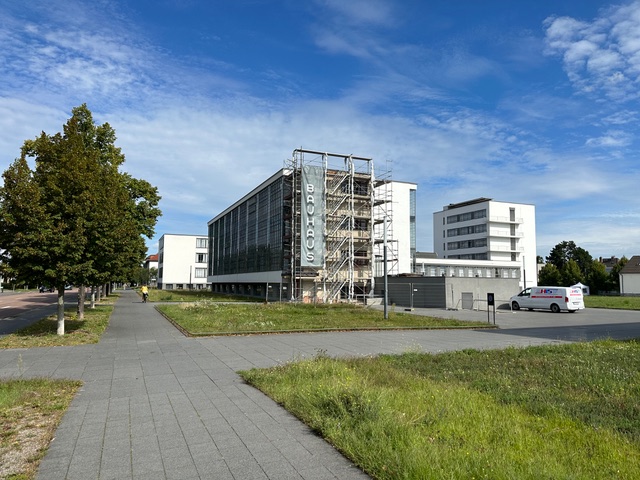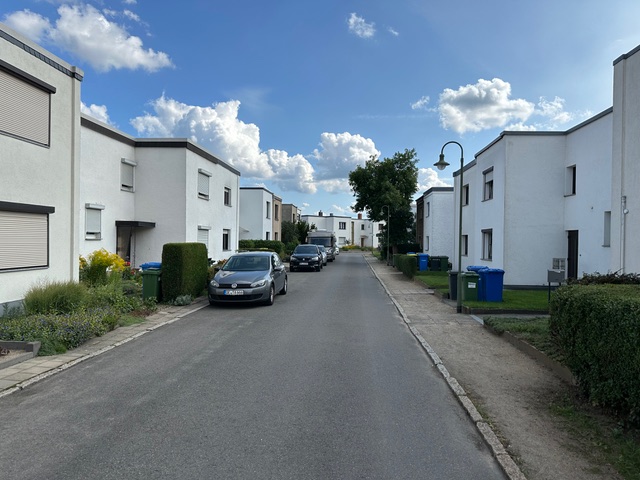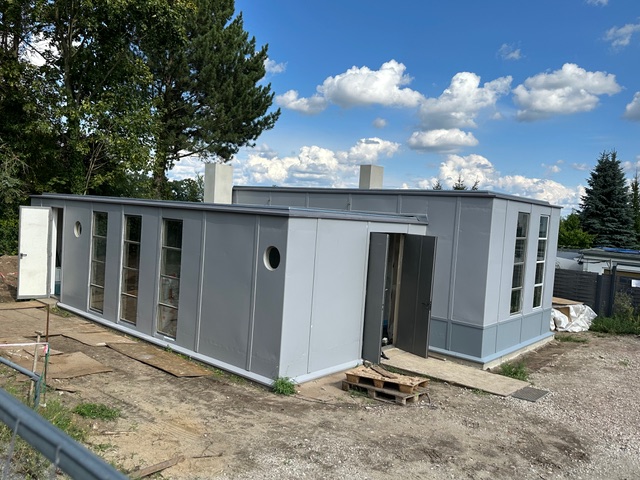
by Greg Dreyer, Class of 2007
Photos by the author
The second Bauhaus School was located in Dessau, population 67,000. Located approximately 80 miles southwest of Berlin, it is easily accessible by train. The school was in operation here between 1925 and 1932. Like Weimar, English is not as widespread as it is in larger cities like Berlin, so my German was helpful during my stay there. Dessau boasts that the city has more original Bauhaus buildings than any other city worldwide.
I started my visit with the Bauhaus Museum Dessau, which opened in time for the Bauhaus centenary in 2019. Designed by addenda architects (sic) of Barcelona, the ground floor of the building is reminiscent of the universal space design concepts of Mies van der Rohe, the last director of the Bauhaus School. It is similar to Crown Hall in Chicago. The exhibits, located on the second floor, were impressive. I enjoyed the examples of interior decoration such as lamps and chairs that the Bauhaus artists designed. I downloaded an app from the Dessau Bauhaus website and listened to the English language audio tour. Exhibits are written in German and English.




After my visit at the museum, I walked over to the nearby Historic Employment Office, designed by Walter Gropius and completed in 1929. The building is still used as a government office building and has a semi-circular shape. It was designed to house employment counselors and job seekers. As they circulated through the curved hallways of the building, job seekers were divided according to gender and type of work sought.


The next day, after studying a map, I realized that the Bauhaus sites I wanted to see were spread throughout the town. There is Bus Line No. 10 that serves all the sites, but it’s schedule wasn’t frequent, and I didn’t take the time to figure out how to buy tickets. To save on steps and move quickly between the sites, I decided to rent a bike from a bicycle rental business next to the train station.
My first stop was the Bauhaus School building, completed in 1926 and designed by Walter Gropius. I have always admired the architecture of the structure. One end of the building is undergoing renovation, as are parts of the interior. Still, I could walk through the building. Much of it is used as exhibit space, and artists are invited in to use the spaces as design studios. To quote a Bauhaus Building brochure, “the load-bearing structure, a skeleton frame made of reinforced concrete and glass, whose transparency, openness and lightness create complex spatial and functional relationships.” The school complex includes a dormitory that is a hotel today. Unfortunately, I was unable to get a room there, and I ended up staying at the Radisson Blu next to the train station, which made up for my disappointment of not being able to live like a Bauhaus student.



My next stop was the nearby Masters’ Houses, built in 1926 and also designed by Gropius. This is a group of houses built for the professors. Director Walter Gropius’s home was built as a single-family home, and three other buildings were semi-detached with two units each. Two of the four buildings were destroyed in a bombing raid during World War II and have since been rebuilt. They are basically empty rooms used for exhibitions or events, but useful for studying the floor plans. One building housed a gallery dedicated to composer Kurt Weill, who was from Dessau.

After the Masters’ Houses, it was about a two-mile bike ride to Kornhaus (architect Carl Fieger, 1927). It’s a rounded building that was constructed as a restaurant along the banks of the beautiful Elbe River. It’s still a restaurant, so I had lunch at their outdoor cafe, enjoying the weather and the view.

My afternoon included a visit to the Törten Housing Estate on the south end of town. This development consists of about 400 residences and was constructed between 1926 and 1930. I stopped at the visitor center in the Konsum Building (Walter Gropius architect, 1928). This building was the center of the estate and included a grocery store, bakery, and cafe. It now houses a visitor center. The taller section of the building is residential.



I biked through the estate and saw the Stahlhaus (Steel House), designed by Georg Muche and Richard Paulick, 1927. The Steel House is undergoing renovation. Built as an experiment, it was used as a residence until 1991.
My two days in Dessau were a dream come true for this Bauhaus fan. If you are inclined to journey there, check out the Bauhaus Dessau website. https://www.bauhaus-dessau.de/en/index.html Keep in mind that English language tours are available, but only once a week. Museums in Germany are usually closed on Mondays, but the Bauhaus museums are open seven days a week during high season.
A note about Berlin: Berlin has the largest Bauhaus museum, known as the Bauhaus-Archiv. It is currently closed until 2025 for construction of an addition to the museum. Meanwhile, there is a temporary Bauhaus Museum located in a storefront. Fortunately, I had visited the Bauhaus-Archiv in 2009 and I look forward to the re-opening of the museum and its new addition. Berlin is also home to several Bauhaus-inspired housing estates which are also worth visiting.

CLICK HERE for more stories on The Bridge.


What a great trip. You got quite a bit accomplished in 2 days.
Thank you. It’s typical of me to sightsee at an exhausting pace.
Interesting, thanks for sharing your visit with us.
Thanks for sharing your journey, Greg! I chuckled when I read that you rode a bike – but OF COURSE you did!
Wow! Biking to see it all is a real feat. Thanks, Greg, for this wonderful story and pictures. It should inspire others to go on a similar Bauhaus exploration.